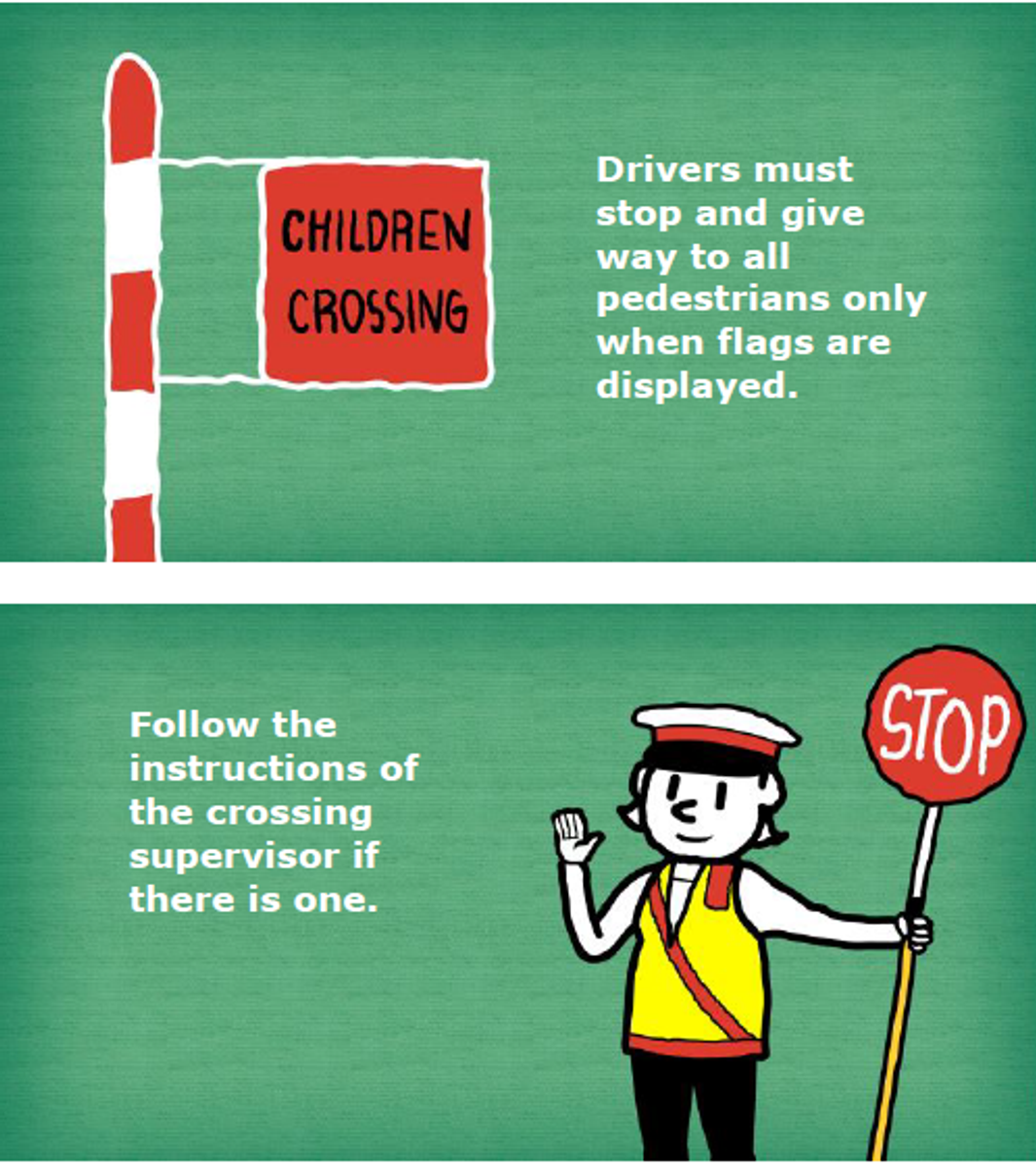SCHOOL CROSSING
Recently, I included some information in the Newsletter about the responsibilities of adults at school crossings.
Sadly I continue to get reports from the Crossing Supervisors that behaviours are still of a concern.
- parents not following crossing instructions and not bothering to walk a few meters to use the crossing.
- parents not waiting for the Crossing Supervisor to use their whistle.
- cars driving on the opposite side of the road to cut in the front of the queue just to pick up their child.
- cars travelling faster than the 40kph speed limit.
- cars not stopping at the crossing even when the Crossing Supervisor was on the crossing requiring them to run back onto the footpath.
- cars parking within 20 metres of the school crossing.
- parents not taking due care when using the Kiss and Drop zones nearly causing collisions as they exit.
Information from VicRoads - Children's crossings
- When flags are displayed all pedestrians should use the crossing.
- Some children's crossings have a crossing supervisor. Always follow the instructions of the crossing supervisor.
- If there isn't a supervisor, look and listen for traffic before crossing.
- Make sure all traffic has stopped before stepping on to the crossing.
- Only cross when it is safe to do so.
- Stay alert - keep looking and listening for traffic while crossing.
Drivers and riders at children's crossings:
- Must not overtake a vehicle stopping or stopped at the crossing.
- Must stop if a child or adult is about to cross or is crossing, even if there is no crossing supervisor.
- Must stop if a hand held "STOP" sign is displayed.
- Must proceed only when all children and adults, including the supervisor, are clear of the crossing.
- Must approach at a speed slow enough to stop safely, if necessary.
- Should always watch out for children near schools.
MANAGING YOUR CHILD’S ANXIETY
If your child feels anxious, reassure them that these feelings are a normal response to new people, events or potentially challenging situations. Help your child understand that there is a great deal they can do to manage their anxious feelings, so they can get on with the activities they enjoy.
If your child is anxious he may struggle to explain how he feels. An important first step in anxiety self-management is explaining to your child how anxiety works.
- Teach your child that the part of the brain that protects them from danger (the amygdala – pronounced ahh-mig-dah-la), is always on high alert when they are anxious
- Explain that the amygdala sees danger where there is none, but the body prepares to fight for life or flee from danger as if it’s protecting them from a hungry lion
- Discuss that the amygdala can’t differentiate between a hungry lion and public speaking or some other task they must face
- Talk about the changes that happen in their body to power them up to fight or flee, including increased heart and breathing rates and the pumping of the blood from the stomach to the arms and legs, which can cause nausea and even vomiting for some
Help recognise anxiety-inducing events
There are many things that can evoke anxiety in your child, including:
- Stressful events
- Life changes
- Transitions
- Difficult experiences
- New or unfamiliar situations
Help your child to recognise the specific situations and events that make them feel anxious such as meeting new friends, sitting tests and fear of rejection. In this way you can help your child manage and minimise their feelings of anxiety.
Respond with empathy
When your child feels anxious, the part of the brain that controls rational thinking, decision-making and concentration temporarily goes offline. They can feel easily overwhelmed by simple, everyday events and situations. Rather than protecting your child by allowing them to avoid meeting these challenges, or dismissing them as trivial, validate their feelings with statements such as:
- “I can see you’re feeling worried about going to camp without your brother.”
- “Thanks for telling me you feel nervous about the test. It’s understandable.”
- “I see you’re really anxious about this right now. I know it’s hard for you.”
Resist the temptation to rescue or fix a situation. Respond with empathy and understanding to your child’s concerns.
Manage anxious moments
Help your child develop the tools to regulate and push their anxious feelings to the background. Practise these anxiety management tools when your child is feeling calm, and it will be easier for them to practise when they are nervous. These include:
- Taking some deep breaths: Deep belly breathing from the diaphragm calms the amygdala, reducing feelings of anxiousness
- Bringing their attention back to the present: Use their senses to bring their attention to the present moment and away from their worries – “Tell me five things you see, four things you hear and something you smell.”
- Getting them moving: Physical exercise is not only a great distraction but it releases feel-good endorphins that help children and young people feel better and more optimistic about the future.
- Defusing their thoughts: Anxious thoughts can get stuck, refusing to budge no matter or how unwanted they are. Help your child to distance themselves from their thoughts by placing distancing statements in front of their thoughts. Replace “I’m going to fail the test” with “I had a thought that I’m going to fail the test.” Rather than changing their thinking, assist your child distance themselves from unhelpful thoughts.
Get the fundamentals right
Sufficient sleep, good nutrition and exercise are essential for anxious kids. Support your child to adhere to their optimal bedtime so they wake naturally each morning, reduce sugar, take care of their gut health through good nutrition and encourage regular exercise for optimal mental health. There is a great deal you can do to help your child manage their anxiety. Start by assisting your child to understand the fundamentals of anxiety, show your genuine understanding of their feelings and be ready to support them emotionally to push their anxiety to the background.
Food for Thought
Regards
Angelika Ireland




